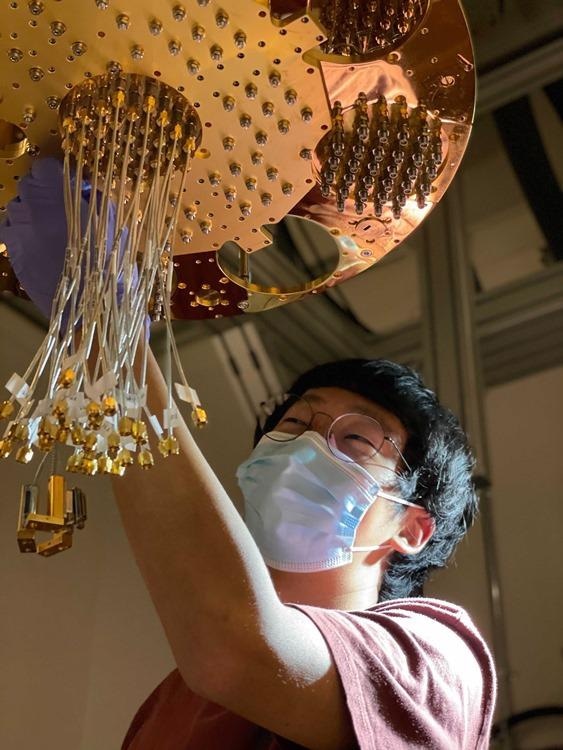The basic building blocks of programmable quantum circuits are high-fidelity quantum logic gates that are applied to quantum bits (qubits).
 Researcher Yosep Kim during the pre-installation of the superconducting QPU for the experiment. Image Credit: Yosep Kim/Berkeley Lab
Researcher Yosep Kim during the pre-installation of the superconducting QPU for the experiment. Image Credit: Yosep Kim/Berkeley Lab
The first experimental demonstration of a three-qubit high-fidelity iToffoli native gate in a superconducting quantum information processor in a single step was performed by researchers at the Advanced Quantum Testbed (AQT) at Lawrence Berkeley National Laboratory (Berkeley Lab).
The varieties of gates that can be implemented directly by hardware are commonly supported by noisy intermediate-scale quantum computers. Complex gates are accomplished by splitting them down into native gate sequences.
For global quantum computing, the team’s demonstration includes a unique and resilient native three-qubit iToffoli gate. Furthermore, the researchers demonstrated a 98.26% fidelity operation of the gate. Nature Physics announced the team’s experimental breakthrough in May 2022.
Quantum Logic Gates, Quantum Circuits
The Toffoli, also known as the controlled-controlled-NOT (CCNOT), is a crucial logical gate in classical computing since it is ubiquitous, allowing it to construct any logic circuit to compute any binary operation. Moreover, it is reversible, allowing the binary inputs (bits) to be determined and recovered from the outputs, ensuring that no information is lost.
The input qubit in quantum circuits can be in a superposition of 0 and 1 states. Since the qubit is physically coupled to other qubits in the circuit, implementing a high-fidelity quantum gate becomes increasingly challenging as the number of qubits grows.
The shorter the quantum circuit, the fewer quantum gates are required to operate, enhancing the implementation of an algorithm before the qubits decohere, generating mistakes in the final result. As a result, easing the quantum gate complexity and operating time is important.
The Toffoli gate, when combined with the Hadamard gate, creates a universal quantum gate set that allows researchers to perform any quantum algorithm.
Experiments using multi-qubit gates in significant computing technologies such as superconducting circuits, trapped ions, and Rydberg atoms demonstrated Toffoli gates on three-qubit gates with fidelities ranging from 87 to 90%.
However, such demonstrations necessitated researchers to break down the Toffoli gates into one- and two-qubit gates, thereby lengthening gate operation time and lowering fidelity.
Creating an Easy-to-Implement Gate
AQT devised an iToffoli gate instead of a traditional Toffoli gate for the experiment, which involves applying simultaneous microwave pulses set at the same frequency to three superconducting qubits in a linear chain.
The experiment showed that, like the Toffoli gate, this three-qubit iToffoli gate can be utilized to execute high-fidelity universal quantum computing.
Researchers also discovered that the gates schematic on superconducting quantum processors could generate additional three-qubit gates, allowing for more efficient gate synthesis — the process of splitting up quantum gates into shorter ones to enhance circuit running speeds.
Yosep Kim, a former postdoc at AQT and now a senior scientist at the Korea Institute of Science and Technology, is among the experiment’s leading researchers.
As a result of decoherence, we know that a longer and more complex gate sequence hurts the fidelity of the results, so total gate operation time to execute a certain algorithm is significant. The demonstration proved that we can implement a three-qubit gate in one step and reduce the circuit depth (the length of the sequence of gates) of a gate synthesis.
Yosep Kim, Lead Researcher and Senior Scientist, Korea Institute of Science and Technology
Kim added, “Furthermore, unlike previous approaches, our gate scheme does not include the qubit's higher excited states prone to decoherence, therefore resulting in a high-fidelity gate.”
I am still highly impressed by the simplicity and the fidelity of this iToffoli gate. Now, using a three-qubit operation like the one in the work can significantly speed up the development of quantum application and quantum error correction.
Alexis Morvan, Research Scientist, Google
Leveraging a State-of-the-Art Collaborative Research Lab
The U.S. Department of Energy Office of Science Advanced Scientific Computing Research program has funded AQT, a cutting-edge collaborative research center for quantum information science. Berkeley Lab runs an open-access experimental testbed for academics and external users from academia, National Laboratories, and commerce.
These dynamic relationships allow for a comprehensive study of cutting-edge science in AQT’s superconducting platform, which is based on high-quality qubits, gates, and error mitigation, while also training new generations of researchers in the area.
Kim stated, “I studied quantum information science using a photonics system during my doctorate, so I didn’t have a good knowledge to conduct the experiment in a superconducting processor.”
He further added, “But because the experimental testbed is so well established and there are many interdisciplinary colleagues who know the inner workings of the setup and collaborated in the experiment, I was able to jump into the experiment very quickly without much previous experience. If it weren’t for AQT’s platform and team, I don’t think my ideas would have been realized at such a high level.”
AQT provides researchers and users a fantastic opportunity to collaborate with people coming from different backgrounds and with varied interests. This iToffoli project is one such example of a cross-pollination of ideas.
Long Nguyen, Postdoctoral Researcher, Advanced Quantum Testbed, Lawrence Berkeley National Laboratory
Nguyen further stated, “So, in addition to the spirit of scientific freedom at AQT, our work was also accelerated by the well-established infrastructure and constant calibration, allowing us to focus on the physics of our specific project without digressing on peripheral tasks. Furthermore, an advanced control stack enabled us to explore all possible implementations to establish novel quantum protocols.”
Researchers anticipate that experimental techniques for high-fidelity and simple-to-implement multi-qubit gates, like those investigated at AQT, will spur more research into developing new multi-qubit gates for innovative quantum information processing.
Journal Reference:
Kim. Y, et al. (2022) High-fidelity three-qubit iToffoli gate for fixed-frequency superconducting qubits. Nature Physics doi:10.1038/s41567-022-01590-3.